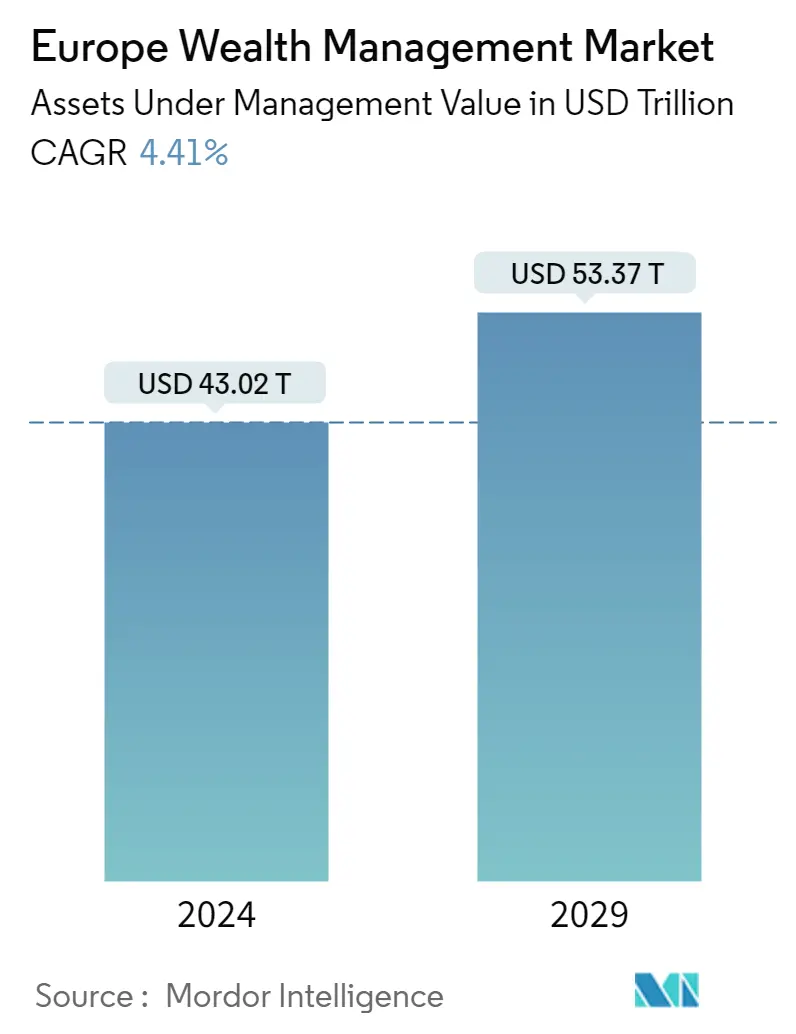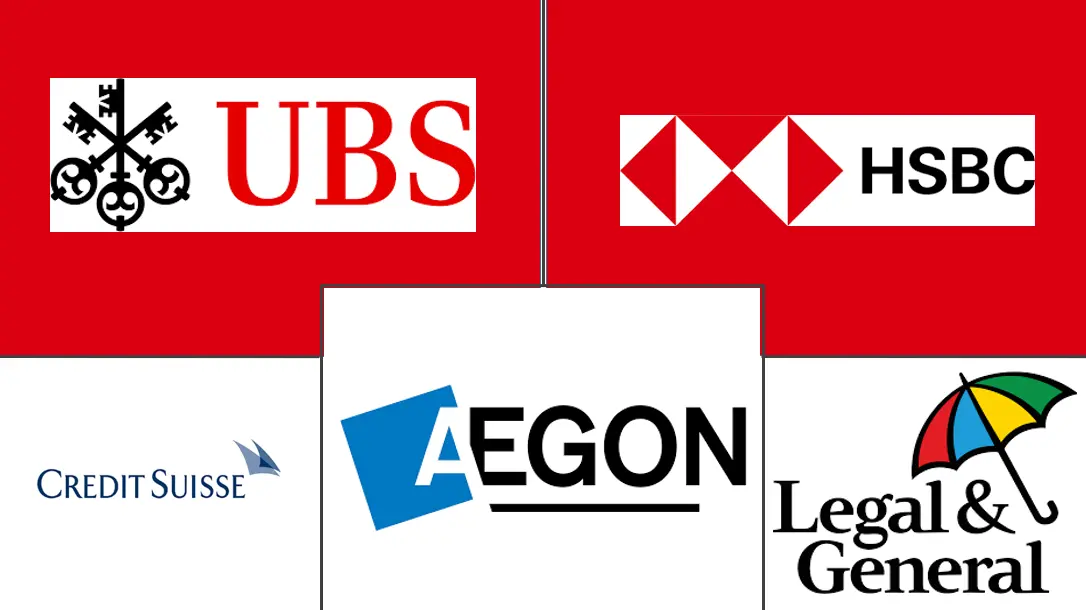Market Size of Europe Wealth Management Industry

| Study Period | 2020 - 2029 |
| Base Year For Estimation | 2023 |
| Market Size (2024) | USD 43.02 Trillion |
| Market Size (2029) | USD 53.37 Trillion |
| CAGR (2024 - 2029) | 4.41 % |
| Market Concentration | Medium |
Major Players
*Disclaimer: Major Players sorted in no particular order |
European Wealth Management Market Analysis
The Europe Wealth Management Market size in terms of assets under management value is expected to grow from USD 43.02 trillion in 2024 to USD 53.37 trillion by 2029, at a CAGR of 4.41% during the forecast period (2024-2029).
The COVID-19 pandemic had a significant impact on the European economy. As a result of the pandemic, investments, transactions, and other financial services were affected. The sudden spread of the COVID-19 crisis has harmed Europe. European countries took stringent measures to combat the viral infection and limited its human-to-human spread, including the closure of numerous commercial and industrial operations. As a result, wealth management companies have been moderately impacted.
With more than EUR 20 trillion (around USD 21 trillion) of financial assets held by individuals, Europe represents one of the largest wealth management opportunities in the world. In some countries, the margins in wealth management are among the highest, and it helps private banks build stronger corporate connections. Many banks are investing more manpower and technologically advanced platforms into their wealth management operations.
There is a growing level of trust in wealth managers and financial markets, driven by the London Stock Exchange and some German and French wealth management companies. These companies are developing digitized products that have changed client behavior. The global economic crisis of 2008 significantly decreased client trust in wealth management firms globally. This resulted in a shift towards safer products such as fixed-income securities and other personalized services. However, the mass affluent offer high growth opportunities for the wealth management industry. AUM (assets under management) grew by 5%, primarily driven by equity market performance, with modest net inflows of 2%.
Moreover, a large chunk of the millionaire population is the baby boomer population, which is included in the mass affluent segment. With accumulated significant wealth, this population in the coming decade will require financial advice for retirement planning, which will present further opportunities for wealth management. The most important factors for the European wealth management market are Britain's Exit from the European Union and the Digitized Platform served by wealth management companies. It means Britain's Exit from the European Union has brought about a change in the market and its positive and negative effects will be seen in the coming years. Although digital alternatives to traditional consumer banking segments are late, wealth managers must automate end-to-end processes, a process that the United Kingdom is leading across the world.
European Wealth Management Industry Segmentation
The wealth management market in Europe is one of the largest and fastest-growing markets in wealth management because people prefer technology-driven and innovative platforms, which make wealth management firms in Europe more efficient. A complete background analysis of the European wealth management market, which includes an assessment of the economy, market overview, market size estimation for key segments, emerging trends in the market, market dynamics, and key company profiles is covered in the report.
The European wealth management market is segmented by client type (HNWI, retail/individuals, mass affluent, and other client types) and wealth management firm type (private bankers, family offices, and other wealth management firms). The report offers market size and forecasts for the European wealth management market in value (USD million) for all the above segments.
| By Client Type | |
| HNWIs | |
| Retail/ Individuals | |
| Mass Affluent | |
| Other Client Types |
| By Wealth Management Firm | |
| Private Bankers | |
| Family Offices | |
| Other Wealth Management Firms |
| By Geography | |
| Italy | |
| Germany | |
| France | |
| United Kingdom | |
| Rest of Europe |
Europe Wealth Management Market Size Summary
The European wealth management market is poised for significant growth, driven by a robust increase in assets under management. Despite the challenges posed by the COVID-19 pandemic, which impacted financial services and led to a temporary decline in client trust, the market has shown resilience. The region's wealth management sector benefits from a substantial pool of financial assets held by individuals, making it one of the largest opportunities globally. The market is characterized by high margins in certain countries, which bolster private banks' corporate connections. The rise of digitized products and platforms has transformed client behavior, with wealth management firms investing in advanced technologies to enhance their services. The mass affluent segment, particularly the baby boomer population, presents lucrative opportunities for retirement planning and personalized financial advice.
The European wealth management industry is highly competitive and fragmented, with numerous players vying for market share across countries like Italy, France, Germany, and the United Kingdom. The market's competitiveness is further fueled by the increasing number of high net worth and ultra-high net worth individuals, which drives demand for wealth management services. Traditional investment opportunities, particularly in the United Kingdom, remain strong, supported by London's financial services. Major international and European firms, such as Credit Suisse, HSBC Holdings, and UBS Group, dominate the market, focusing on technological innovations to enhance their offerings. The market's growth is also supported by rising house prices and falling debt prices, which provide additional funding avenues for personal and business entities.
Europe Wealth Management Market Size - Table of Contents
-
1. MARKET INSIGHTS AND DYNAMICS
-
1.1 Market Overview
-
1.1.1 Number of HNWIs and their Wealth in Europe Over the Years
-
-
1.2 Market Drivers
-
1.3 Market Restraints
-
1.4 Technological Advancement Shaping the Wealth Management Landscape in the Region
-
1.4.1 Insights on Digital Platform and their Adoption Levels across the Value Chain Wealth Management in the Region
-
1.4.2 Adoption of New Age Digital Platforms by Millenials
-
1.4.3 Insights on Robo Advisors and the Other Applications of Artificial Intelligence Techniques in Wealth Management Industry
-
-
1.5 Porter's Five Forces Analysis
-
1.5.1 Threat of New Entrant
-
1.5.2 Bargaining Power of Buyers/ Consumers
-
1.5.3 Bargaining Power of Suppliers
-
1.5.4 Threat of Substitute Product
-
1.5.5 Intensity of Competitive Rivalry
-
-
1.6 Intensity on Industry Policies and Regulations impacting the Wealth Management Industry of Europe
-
1.7 Insights into Alternative Assets Considered for Financial Planning By Wealth Managers in the Region
-
1.7.1 Prominence of ESG Investing Among HNWIs in the region
-
1.7.2 Insight into the infrastructure Related Needs of the Region that Drive the investment patterns of HNWIs
-
-
1.8 Impact of COVID-19 on the Market
-
-
2. MARKET SEGMENTATION
-
2.1 By Client Type
-
2.1.1 HNWIs
-
2.1.2 Retail/ Individuals
-
2.1.3 Mass Affluent
-
2.1.4 Other Client Types
-
-
2.2 By Wealth Management Firm
-
2.2.1 Private Bankers
-
2.2.2 Family Offices
-
2.2.3 Other Wealth Management Firms
-
-
2.3 By Geography
-
2.3.1 Italy
-
2.3.2 Germany
-
2.3.3 France
-
2.3.4 United Kingdom
-
2.3.5 Rest of Europe
-
-
Europe Wealth Management Market Size FAQs
How big is the Europe Wealth Management Market?
The Europe Wealth Management Market size is expected to reach USD 43.02 trillion in 2024 and grow at a CAGR of 4.41% to reach USD 53.37 trillion by 2029.
What is the current Europe Wealth Management Market size?
In 2024, the Europe Wealth Management Market size is expected to reach USD 43.02 trillion.

